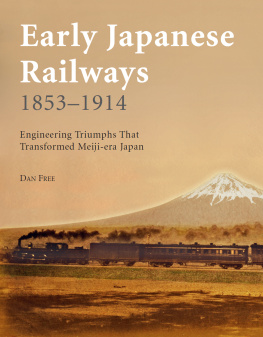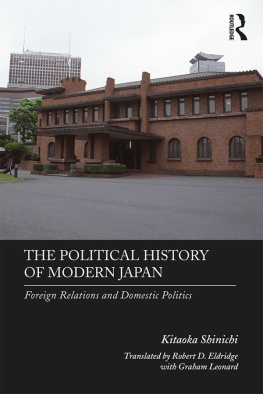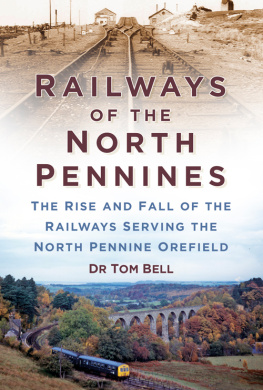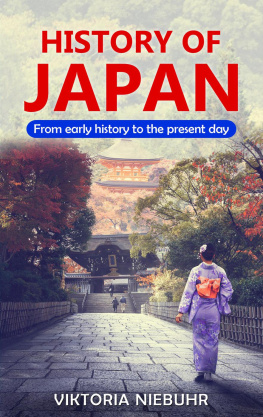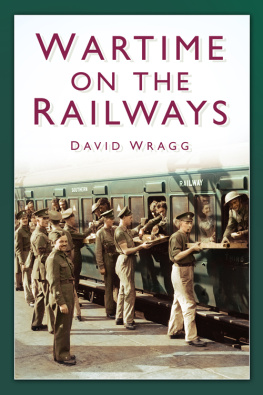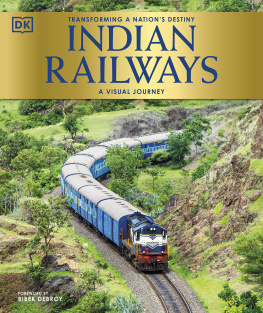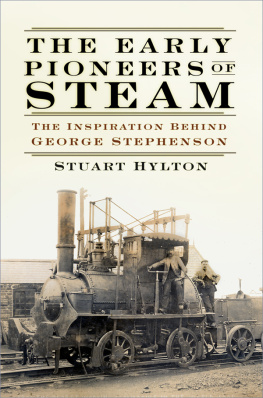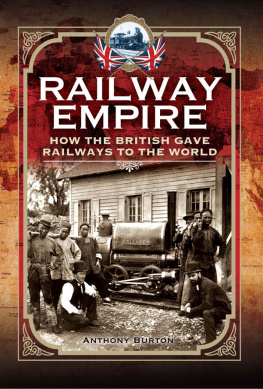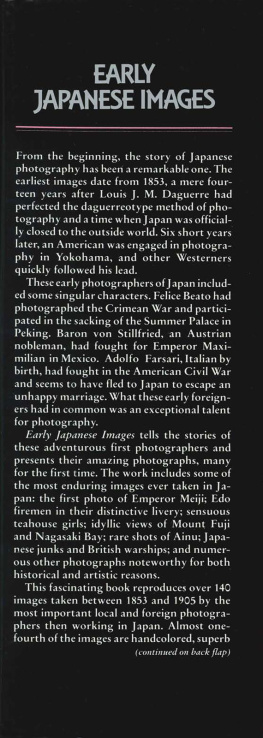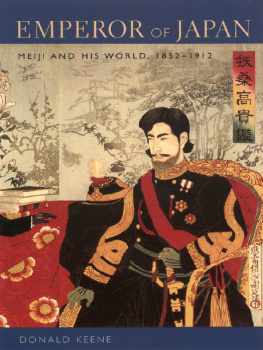ACKNOWLEDGMENTS
Many people assisted me in the research and preparation of this book, but the following merit particular mention and thanks: John Agnew, New Zealand; Charles Bates, Allen County Museum, Lima, Ohio; Onouchi Makoto, Tky; John Buydos, Dr. Tomoko Steen and Sayuri Umeda, Library of Congress; Dr. Steven Ericson, Dartmouth College; Sr. Jane Gates, Medical Mission Sisters, Philadelphia; Dr. Charles W. Kinzer, Annapolis; Kohashi Noriko, Los Angeles; Komine Hiroyasu, Yokohama; Kenneth Mencz, New York; The National Archives and Records Administration Staff, New York Regional Office; Zoe Rees and Judith Dennison, Birmingham City Archives, UK; and Sakakihara Asakichi, San Francisco.
Among those who have been particularly more generous than I deserve with both their time and assistance are: Kawano Keiko, The Railway Museum, miya; Terry Bennett, early Japanese photographic authority sans pareil whose assistance, advise, and guidance has been invaluable; Reg Carter, the late librarian of the Stephenson Locomotive Society, UK, who sadly did not live to see publication of this book; and Dr. Aoki Eiichi, one of Japans pre-eminent railway historians who graciously agreed to review the manuscript and offer comments. Finally, I must give heartfelt thanks to two individuals who helped me verify numerous dates, checked seemingly countless facts, and who offered help when my research abilities were at the limits of what could be accomplished outside of Japan, devoting untold hours with unwavering enthusiasm and providing encouragement at every turn in the road, Nakagane Jun, Yokohama and Ozawa Tomio, Tky.
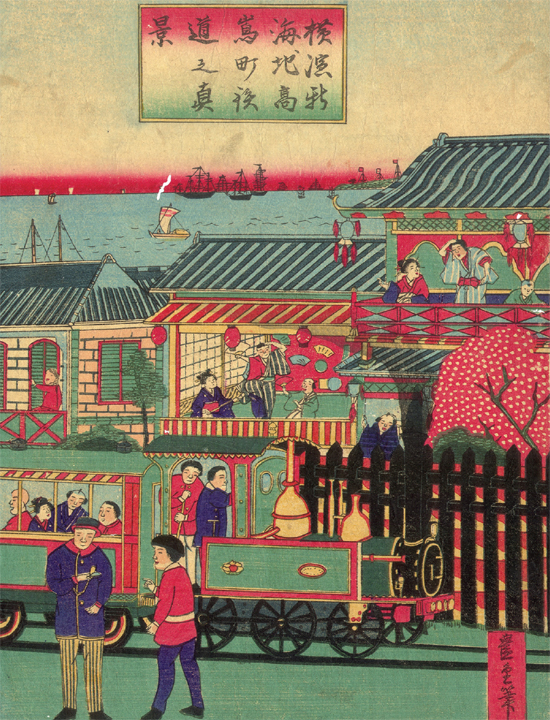
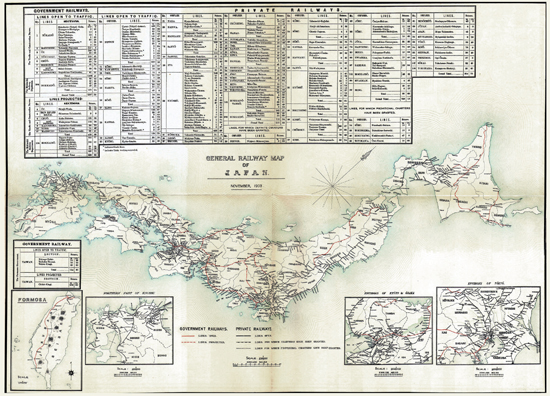
APPENDIX
ORIGINAL METROPOLITAN TERMINII OF PRINCIPAL MEIJI ERA NON-GOVERNMENT RAILWAYS
| Hankai/Nankai Tetsudo | Namba (Osaka) |
| Kansai Tetsudo | Minatomachi (Osaka) |
| Aichi station (Nagoya) |
| Kobu Tetsudo | Iidamachi (running rights to Manseibashi) |
| Koya Tetsudo | Shiomibashi |
| Kyoto Tetsudo | Nijo (with Tambaguchi intermediate station and running rights to Kyoto station) |
| Nippon Tetsudo | Ueno (running rights to Shimbashi via Akabane) |
| San'yo Tetsudo | Hyogo (running rights to Kobe Station) |
| Sobu Tetsudo | Honjo (renamed Kinshicho in 1915) |
| Tobu Tetsudo | from 1899: Senju/from 1902: Azumabashi, renamed Akasuka in 1909, present day Narihirabashi |
WORKSHOP LOCATIONS
| IJGR | Kobe (loco building ceased in 1909) |
| Nagano |
| Shimbashi/Hamamatsu |
| Takatori (moved from Kobe shops) |
| Tsuchizaki |
| HTTKK | Temiya (later IJGR) |
| Kansai | Yokkaichi (later IJGR) |
| Kyushu | Kokura (later IJGR) |
| Nippon Tetsudo | Omiya (later IJGR) |
| San'yo Tetsudo | Hyogo (later IJGR) |
GAUGE EQUIVALENTS AND REPRESENTATIVE LINES
| 576mm = 1 shaku 9 sun | (Gumma Basha) |
| 600mm | (Chiba-ken, Narita) |
| 610mm = 2' 0" | (Aso, Kishu Mine, Mamurogawa, Musashino Mura, Perry's Gift Railway, Tateyama) |
| 635mm = 2' 1" | (Iwafune Jinsha) |
| 660mm | (Kito Basha) |
| 666mm = 2 shaku 2 sun | (Yamanashi Basha, Hongo) |
| 737mm = 2' 5" | (Furukawa Basha, Shinagawa Basha) |
| 750mm = 2' 5" | (Japanese logging railways) |
| 753mm = 2 shaku 5 sun | (Fuhoku) |
| 762mm = 2' 6" | (Glover Co. demo line, Kinki Nippon, Kurobe Valley, Seibu) |
| 838mm = 2' 9" | (Kamaishi, early Hankai) |
| 914mm = 3' 0" | (Koiwai Kido, Otaru Tetsudo, Yutoku Kido, several Kyushu lines) |
| 1000mm = 3' 3" | (Meter gauge) |
| 1067mm = 3' 6" | (Japanese Standard Gauge, "Cape Gauge") |
| 1372mm = 4' 6" | (lokyo, Hakodate, & Yokohama Tramways, Tokyu Tetsudo Setagaya Line, Tokyo Metro Shinjuku Line, Keio Tetsudo) |
| 1391mm = 4' 6" | (Akita Municipal Tramway) |
| 1435mm = 4' 8" | (World Standard Gauge, Shinkansen, Tokyo Subway, Keisei, Keihan, Hankyu, Hanshin, Hokusou Kaihatsu, Keihin Kyuko, Kintetsu, Nishi Nippon, Hakone Tozan) |
Gauges shown in bold were based on a traditional Japanese measurement: 1 shaku = 10 sun = 303.03mm.
IJGR LOCOMOTIVE NUMBERING SCHEMES 18721909
18721874
(Up to opening of the Kbesaka Line)
| Class | Running Number(s) | Builder | 1909 Designation |
| A | | Yorkshire | |
| B | 2, 3, 4, 5 | Sharp Stewart | |
| C | 6,7 | Avonside | (none, moved to Taiwan) |
| D | 8,9 | Dubs | |
| E | | Vulcan | |
* * * * * * * * *
18741891
(Up to opening of the Tokaid Line)
With the opening of the Kbesaka Line in 1874, locomotives running on the Shimbashi line were assigned odd numbers, while locomotives on the Kbe sakaKyto and the later TsurugaNagahama-gaki Lines were assigned even numbers. Abt cogged locomotives for the Shinetsu line were also given even numbers, while conventional steam locomotives on that line were given odd numbers. Classes of locomotives were assigned a single letter designation from the Roman alphabet, and after the Romaji alphabet had been exhausted, the system was continued in AA, AB, AC, AD, etc. fashion. Those running numbers for which records remain or have been discovered are as follows:
Shimbashi Line (renumbering):
| Class | Renumbered | Builder | 1909 Designation |
| A | | Yorkshire | |
| B | 2, 3, 4, 5 13, 15, 17, 19 | Sharp Stewart | |
| C | 6, 7 5, 7 | Avonside | (none, moved to Taiwan) |
| D | 8, 9 9, 11 | Dubs | |
| E | | Vulcan | |
KbesakaKyto Line
| Class | Running Number(s) | Builder | 1909 Designation |
| F | 6, 8, 10, 12 | Stephenson (2-4-0T) | |
| H | 22, 24 | Manning Wardle | 1290 |
| (0-6-0T) |
| N (L on | 14, 16, 18, 20 | Kitson (0-6-0T; 2 | 5100/7010 |
| reb'ld.) | rebuilt as 4-4-0s/2 |
| rebuilt as 0-6-0s) |
| O | 2, 4 | Sharp Stewart (0-4-2) | 5000 |
| Z | 70, 72, 74, 76, 78, 80 | Dubs | 1850 |
TsurugaNagahamagaki Line
| Class | Running Number(s) | Builder | 1909 Designation |
| Y | 54, 56, 58, 60, 62, 64, 66, 68 | Kitson (0-6-0T) | 1800 |
NaoetsuUeda (later Shinetsu) Line
| Class | Running Number(s) | Builder | 1909 Designation |
| I | 59,77,79,81,83, 85, 87, 190 | Nasmyth Wilson | 1100 |
| Z | 61, 63, 65, 67, 97, 99, 101, 103 | Dubs | 1850 |
* * * * * * * * *

